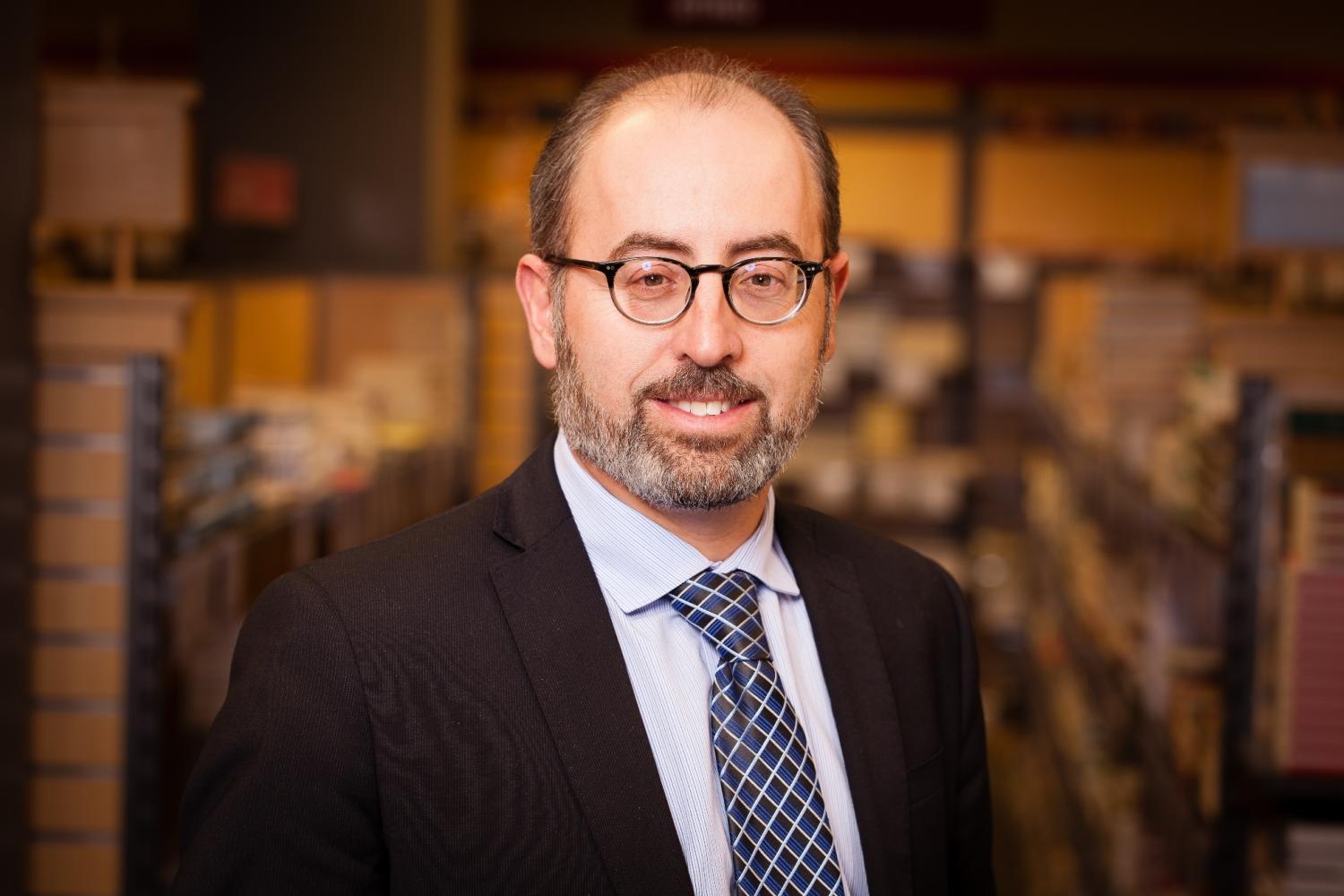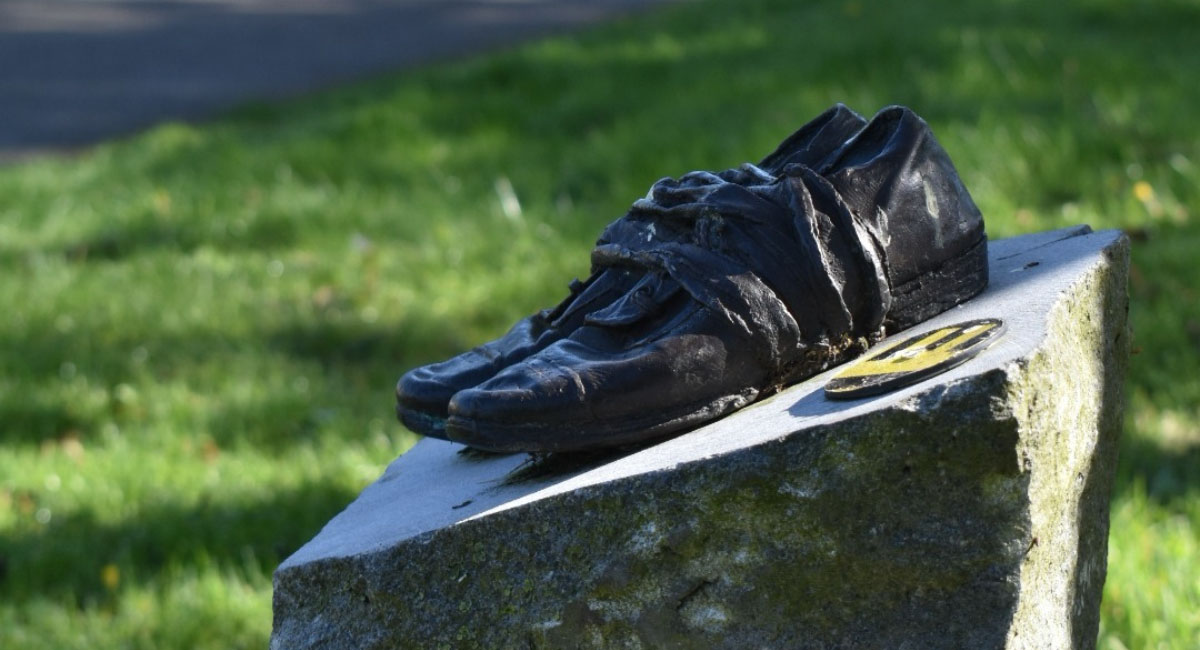
Honouring Indigenous Aid Towards Irish Famine Relief in Canada
The Irish Famine of 1846-1852 was one of the darkest events in Ireland’s history, effectively reducing the population of eight million by half. However, a beacon of light emerged from Canada’s Indigenous peoples, who provided aid to Irish migrants who arrived in Canada, fleeing the famine. To honour their selfless service, the Embassy of Ireland in Canada will host an event on April 11, paying tribute to the Indigenous first responders.
This year marks 85 years of diplomatic relations between Canada and Ireland. With over 4.4 million Canadians (approximately 12 percent of the population) claiming Irish ancestry, the Irish are the third-largest ethnic group in Canada. While the history of the Irish in Canada dates back to the fifteenth century, the 285,000 Irish famine emigrants who came to Canada by ship between 1847 and 1852 to escape the famine in Ireland are also a significant part of Canada’s history.
While estimates suggest that 20 percent of them died during the voyage or due to disease, the remaining survived and went on to play a huge role in shaping Canada. However, the success story of these surviving Irish famine emigrants is tightly knit to the aid they received from the Indigenous nations and bands who provided food and raised funds, despite their own limited privations.
Gratitude: Honouring Indigenous Aid
In acknowledgement of the great contribution to the Irish famine relief efforts by the Indigenous nations of Canada, the Embassy of Ireland in Canada, in collaboration with the Irish Heritage Trust, University of St. Michael’s College, Toronto and the National Famine Museum, Strokestown Park, Ireland is hosting an event called ‘Gratitude’ on April 11 at the Irish residence in Ottawa.
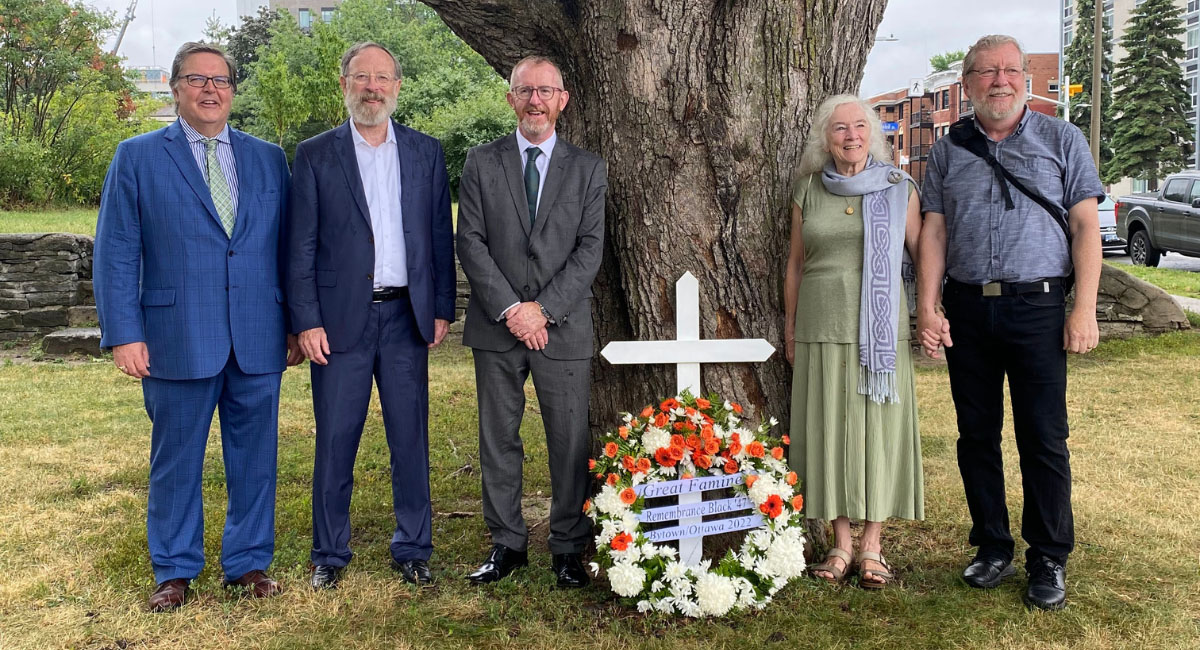
ABOVE: Black ’47 Memorial Ceremony held at Macdonald Gardens Park on August 4, 2022. (FROM LEFT): M.P James Maloney, Chair of Canada-Ireland Interparliamentary Group (CAIE), Michael McBane, chairperson of the Bytown 1847 Irish Famine Monument Committee, Ambassador Eamonn McKee, Patricia Marshall, member of the Bytown 1847 Irish Famine Monument Committee and Mark McGowan, Professor of History and Celtic Studies at University of St. Michael’s College, University of Toronto.
Elaborating on the details of the event, Eamonn McKee, Ambassador of Ireland to Canada, Jamaica, The Bahamas, Antigua and Barbuda, says, “The event will commence with a tree planting ceremony of three river birch trees in the front garden of the Irish residence (symbolic of the Indigenous contribution as these trees are native to Canada), followed by speeches by myself, Nathan Brinklow, Director, Indigenous Studies, Department of Languages, Literatures and Cultures, Queen’s University, Kingston and a member of the Turtle Clan from the Tyendinaga Mohawk Territory, Claudette Commanda, Chancellor of the University of Ottawa and an Algonquin Anishinabe from the Kitigan Zibi Anishinabeg First Nation of Quebec, Dr. Jason King, Academic Coordinator of the Irish Heritage Trust and Project Manager of Honouring Indigenous Aid 2024, Mark G. McGowan, Professor of History and Celtic Studies at University of St. Michael’s College, University of Toronto and Chair of its Truth and Reconciliation Committee and Dr. Duke Redbird, an Elder from the Saugeen Ojibway Nation and a member of the Truth and Reconciliation Committee of University of St. Michael’s College, University of Toronto.”
This will be followed by a reception for guests that will include Nancy Smyth, Ambassador of Canada to Ireland, Mary Simon, Governor General of Canada, Edith Dumont, Lieutenant Governor of Ontario, Manon Jeannotte, Lieutenant Governor of Quebec, Murray Sinclair, Co-Chair of the Aboriginal Justice Inquiry of Manitoba and Chief Commissioner of Canada’s Indian Residential Schools Truth and Reconciliation Commission (TRC), key representatives of Global Affairs Canada, parliamentary members from the Executive Committee of Canada-Ireland Interparliamentary Group (CAIE), chiefs and council members of various Indigenous bands including Assembly of First Nations, the Mohawk Council of Akwesasne, the Dene Nation, the Kitigan Zibi Anishinabeg First Nation and the Assembly of Seven Generations, members of the Congress of Aboriginal Peoples, officials from the Odawa Native Friendship Centre, representatives from the Indigenous Policy Department and key members of the Commission – National Inquiry into Missing and Murdered Indigenous Women and Girls.
“There will also be an open mic for those in attendance at the reception to share their stories, and a combination of Irish and Indigenous music will be played,” McKee adds.
Extension of the Global Irish Emigrant Way: the Famine Emigrant Way Canada
The National Famine Commemoration Day is on May 19. In remembrance of the Irish famine victims, a walk along the National Famine Way Heritage Trail is being conducted from Strokestown, Roscommon, to Dublin in Ireland between May 20-25 to mark the route of 1,490 Strokestown residents who walked 165 km to Dublin port — a part of the 285,000 Irish immigrants who fled the Irish Famine to Canada in 1847. The route is marked by over thirty casts of Bronze Shoes markers based on an original pair retrieved from the thatched roof of a 19th-century cottage. Schools and local figures will also be part of the walk.
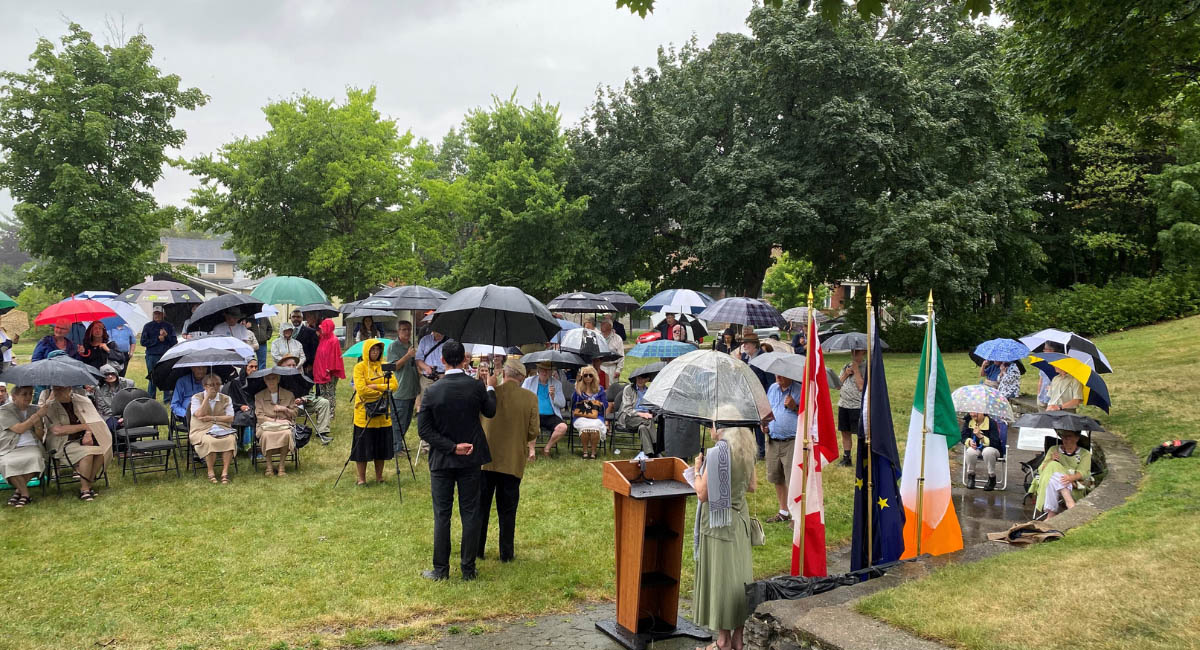
ABOVE: Black ’47 Memorial Ceremony held at Macdonald Gardens Park on August 4, 2022. M.P James Maloney, Chair of Canada-Ireland Interparliamentary Group (CAIE) addresses the gathering.
Moreover, a series of events is being planned between May and October around the Global Irish Famine Way in association with the Embassy of Ireland, Ottawa, the National Famine Museum, Strokestown Park (Irish Heritage Trust), academic experts, local community groups and heritage agencies, including Parks Canada. The extension of the Famine Emigrant Way to Canada will begin with the transportation of the bronze shoes from Galway, Ireland, aboard the Irish research vessel Celtic Explorer, at the beginning of May to St John’s, Newfoundland and Labrador in Canada.
The Bronze Shoes will then be distributed and installed at a number of sites in Canada enclosing the remains of Irish famine emigrants, including Quebec City, Grosse Île, Montreal, St. John’s, Ottawa and Toronto. The sites marked with Bronze Shoes will have QR codes that will provide access to local information and links to the Global Irish Emigrant Way in Ireland. In due course, more sites are set to be added to the Famine Emigrant Trail in Canada in association with Canadian tourism and heritage agencies.
Explaining how Ottawa will feature in the Famine Emigrant Way to Canada, McKee avers, “In 1847, there were probably some 3000-4000 Irish famine emigrants coming up the Ottawa River or Rideau Canal to Ottawa (then Bytown) because of the presence of Irish emigrants in Ottawa and Gatineau. Approximately 300 of them died from typhus and other diseases and were buried in the Sandy Hill Cemetery, which later became the Macdonald Gardens Park. We have received funding for ground penetrating radar to find the exact spot of these remains in the park, and we are hoping to install a pair of Bronze Shoes at the park or Saint Brigid’s Centre, an Irish cultural centre in nearby ByWard Market.”
The Irish Embassy is also co-hosting a conference with St. Michael’s College at the University of Toronto entitled ‘Canada, Ireland and Transatlantic Colonialism’ on May 28-30, which will reference the Famine Emigrant Way.
A series of sites marked by Bronze Shoes will also be erected in the UK, US, South Africa and Australia as part of the Global Irish Famine Way, tracing the journey of the Irish famine emigrants to these countries. Additionally, plans are underway for a major conference of countries involved in the Global Irish Emigrant Way at the National Famine Museum in 2027 to mark the 180th anniversary of Black ’47, the worst year of the Irish Famine.
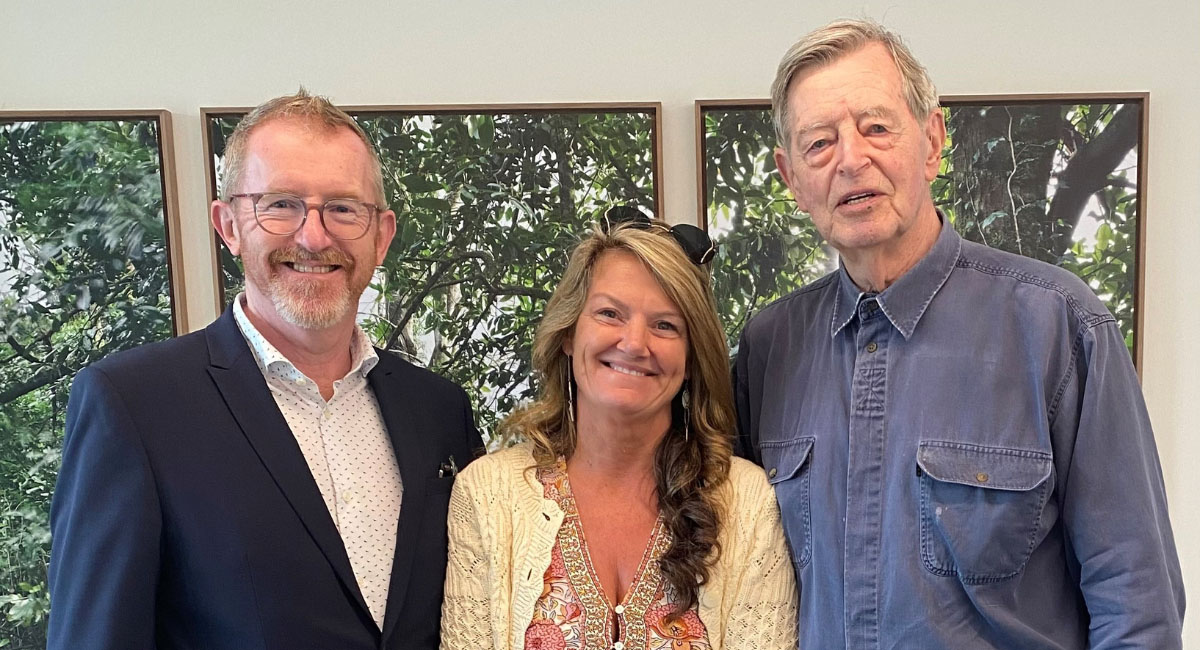
ABOVE: Ambassador Eamonn McKee with Caroilin Callery, Chair, National Famine Way and Director, Irish Heritage Trust and her father, Jim Callery, Director of Westward Holdings and proprietor of the National Famine Museum at Strokestown House
Fostering deeper relations between Ireland and Canada
According to McKee, the extension of the Global Irish Emigrant Way to Canada is an opportunity to thank Canadians for ‘extending compassion to the stranger on their shore’. However, it is also aimed at raising awareness, since few people know what Canada’s role was in the Irish famine. Through this and other projects spearheaded by McKee, such as the ‘Fifty Irish Lives in Canada’ – a compilation of 50 Irish emigrants who have made a significant impact on Canada (set to be published as a book later this year) and several speaking engagements around the Irish influence in Canada, McKee hopes to promote the shared heritage of Ireland and Canada. “I would like to see the Global Irish Emigrant Way as a subset of a broader Irish Canadian Heritage Trail. In learning about our shared history, we realise how it shapes our present and how we can use this knowledge to transform the future,” remarks McKee.
This is Ambassador McKee’s fourth and final year as ambassador to Canada, a position he took up in October 2020. As he prepares to leave Ottawa at the end of August and head back to Dublin, he sheds light on memories he will take back with him. “Despite the lockdown for the first two years, I have so many memories. Landscapes from Newfoundland’s coast and Nova Scotia’s inlets to Canada’s High Arctic, endless woodlands and massive rivers. Quebec City, magical in a snowstorm. Of the people, so many Irish communities that treasure their family ancestry and Irish heritage. That was a revelation. I will take back many memories of and admiration for the storykeepers: I found them in these local communities, curators at the Canadian Museum of History, Indigenous elders and all the local historians of the story of the Irish here. I formed deep friendships that I will keep and cherish for many years to come.”
Header image: Bronze shoes on the National Famine Way, Ireland
PHOTOS: Courtesy of the Embassy of Ireland in Canada

